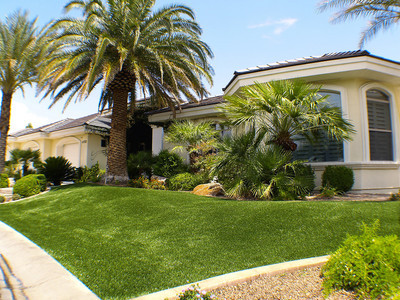Good Greens
When it comes to lawns, everyone tells us to be water-wise, green and eco-friendly. But some of us are too stubborn to get rid of our real grass in spite of high water bills, in spite of having to mow every week and in spite of the difficulty of trying to remove the green and brown stains that children get on their clothes after a two-hour game of tag.
The answer: synthetic grass.
It may not be the perfect answer, but it makes sense when you consider that the average American homeowner spends more than 40 hours a year on lawn care when he could be watching reruns of his favorite television show.
Randy Kleiner, owner of Southwest Greens, said synthetic turf has come a long way since the early days of Astroturf (or what many still call indoor-outdoor carpeting).
"Synthetic grass looks and feels like real grass but without the mowing, watering and fertilizing," he said. "It provides a perfectly manicured green lawn under all weather conditions."
Kleiner is currently installing a long-bladed, natural-looking turf made of polyethylene or polyethylene combined with nylon. It comes in all shapes, widths, heights and even color variations. In fact, Las Vegas is the most popular locale for synthetic turf with more of it appearing here than anywhere else in the world.
Most homeowners do their front yards because the synthetic turf provides a solid green look throughout the year, which in turn makes for strong curb appeal. That curb appeal translates into added value when it comes time to sell the home.
Frank Strnad, co-owner of Field Turf of Nevada, is laying the same kind of synthetic turf that is used on sports fields at many Clark County high schools.
"Our work can be seen at Valley, Rancho, Clark, Arbor View (high schools) and the new soccer fields at McCarran Market Place near the airport," he said. "This gives you an idea of how durable the product is. And if customers don't want the turf in their front yard, then we install putting greens in the back using a metal putting cup assembly just like those on actual golf courses."
Strnad said synthetic grass is soft and feels like grass except that the infill and ground beneath it provides for a more cushioned step. Grass lengths vary from 1.5-2.5 inches though 90 percent of his jobs are 2-inch landscape grass. And if you want to plant trees and shrubs or construct other landscape improvements after the installation, do it yourself or call Strnad for some advice.
Kleiner said the conversion of a 1,600-square-foot front yard to synthetic turf can be done in one day.
"The day before I arrive, I'll have a crew removing the actual grass and preparing the yard," he said. "We cap off irrigation, lay down the turf and make it look just right. The cost averages about $6-$7 a square foot and that comes with an eight-year warranty and a life expectancy of 15-20 years."
When it comes to maintaining synthetic turf, Kleiner said to think of the carpet in your home.
"Synthetic turf maintenance depends on the amount of foot traffic it's going to receive," he said. "If you have two kids and two dogs running and playing on it daily, then it needs a regular brooming to fluff it up and prevent it from laying flat -- just like what happens when you vacuum carpet in your home."
Strnad maintains 3,000 square feet of synthetic turf at his home.
"In the fall, I blow off leaves and rake them up about twice a month," he said. "During the summer, I hose it down once a month, rinsing off dust and dirt."
In addition to less maintenance, synthetic turf promotes water conservation, a topic of great concern in the Las Vegas Valley.
Both Kleiner and Strnad are authorized Water Smart contractors and suggest customers contact the Southern Nevada Water Authority (www.snwa.com) to inquire about the Water Smart Landscapes rebate program.
"Property owners who convert natural grass to synthetic turf will be rebated $1.50 per square foot of removed grass with no cap on maximum square footage," Strnad said. "It's a smart investment."
According to J.C. Davis, public information coordinator for SNWA, every square foot of grass replaced with some type of water-smart landscaping saves an average of 55 gallons of water per year.






















